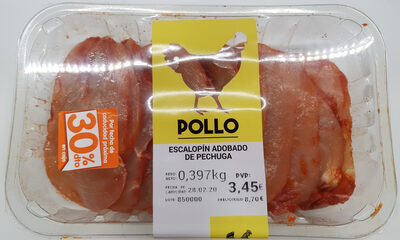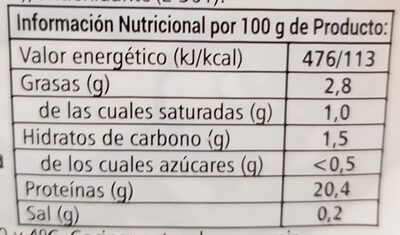Help us make food transparency the norm!
As a non-profit organization, we depend on your donations to continue informing consumers around the world about what they eat.
The food revolution starts with you!
Escalopín adobado de pechuga - dia
Escalopín adobado de pechuga - dia
This product page is not complete. You can help to complete it by editing it and adding more data from the photos we have, or by taking more photos using the app for Android or iPhone/iPad. Thank you!
×
Barcode: 2500321003455 (EAN / EAN-13)
Packaging: Plastic
Brands: Dia
Categories: Meats and their products, Meats, Chicken and its products, Poultries, Chickens, Chicken breasts
Labels, certifications, awards: No gluten, No eggs, No lactose
Origin of ingredients: Spain
Manufacturing or processing places: Toledo, España
Traceability code: ES 10.025658/TO CE
Link to the product page on the official site of the producer: http://www.uvesa.es
Stores: Dia
Countries where sold: Spain
Matching with your preferences
Health
Ingredients
-
11 ingredients
: pechuga de pollo 93%, agua 4%, sal, pimentón, dextrina, especias, correctores de la acidez (E262, E331), antioxidante (E301).
Food processing
-
Ultra processed foods
Elements that indicate the product is in the 4 - Ultra processed food and drink products group:
- Additive: E1400 - Dextrin
Food products are classified into 4 groups according to their degree of processing:
- Unprocessed or minimally processed foods
- Processed culinary ingredients
- Processed foods
- Ultra processed foods
The determination of the group is based on the category of the product and on the ingredients it contains.
Additives
-
E1400 - Dextrin
Dextrin: Dextrins are a group of low-molecular-weight carbohydrates produced by the hydrolysis of starch or glycogen. Dextrins are mixtures of polymers of D-glucose units linked by α--1→4- or α--1→6- glycosidic bonds. Dextrins can be produced from starch using enzymes like amylases, as during digestion in the human body and during malting and mashing, or by applying dry heat under acidic conditions -pyrolysis or roasting-. The latter process is used industrially, and also occurs on the surface of bread during the baking process, contributing to flavor, color and crispness. Dextrins produced by heat are also known as pyrodextrins. The starch hydrolyses during roasting under acidic conditions, and short-chained starch parts partially rebranch with α--1‚6- bonds to the degraded starch molecule. See also Maillard Reaction. Dextrins are white, yellow, or brown powders that are partially or fully water-soluble, yielding optically active solutions of low viscosity. Most of them can be detected with iodine solution, giving a red coloration; one distinguishes erythrodextrin -dextrin that colours red- and achrodextrin -giving no colour-. White and yellow dextrins from starch roasted with little or no acid are called British gum.Source: Wikipedia
-
E262 - Sodium acetates
Sodium acetate: Sodium acetate, CH3COONa, also abbreviated NaOAc, is the sodium salt of acetic acid. This colorless deliquescent salt has a wide range of uses.Source: Wikipedia
-
E301 - Sodium ascorbate
Sodium ascorbate: Sodium ascorbate is one of a number of mineral salts of ascorbic acid -vitamin C-. The molecular formula of this chemical compound is C6H7NaO6. As the sodium salt of ascorbic acid, it is known as a mineral ascorbate. It has not been demonstrated to be more bioavailable than any other form of vitamin C supplement.Sodium ascorbate normally provides 131 mg of sodium per 1‚000 mg of ascorbic acid -1‚000 mg of sodium ascorbate contains 889 mg of ascorbic acid and 111 mg of sodium-. As a food additive, it has the E number E301 and is used as an antioxidant and an acidity regulator. It is approved for use as a food additive in the EU, USA, and Australia and New Zealand.In in vitro studies, sodium ascorbate has been found to produce cytotoxic effects in various malignant cell lines, which include melanoma cells that are particularly susceptible.Source: Wikipedia
-
E331 - Sodium citrates
Sodium citrate: Sodium citrate may refer to any of the sodium salts of citrate -though most commonly the third-: Monosodium citrate Disodium citrate Trisodium citrateThe three forms of the salt are collectively known by the E number E331. Sodium citrates are used as acidity regulators in food and drinks, and also as emulsifiers for oils. They enable cheeses to melt without becoming greasy.Source: Wikipedia
Ingredients analysis
-
Palm oil free
No ingredients containing palm oil detected
-
Non-vegan
Non-vegan ingredients: Chicken breast
-
Non-vegetarian
Non-vegetarian ingredients: Chicken breast
-
Details of the analysis of the ingredients
: pechuga de pollo 93%, agua 4%, sal, pimentón, dextrina, especias, correctores de la acidez (e262, e331), antioxidante (e301)- pechuga de pollo -> en:chicken-breast - vegan: no - vegetarian: no - ciqual_food_code: 36018 - percent_min: 93 - percent: 93 - percent_max: 93
- agua -> en:water - vegan: yes - vegetarian: yes - ciqual_food_code: 18066 - percent_min: 4 - percent: 4 - percent_max: 4
- sal -> en:salt - vegan: yes - vegetarian: yes - ciqual_food_code: 11058 - percent_min: 0.5 - percent_max: 3
- pimentón -> en:paprika - vegan: yes - vegetarian: yes - ciqual_food_code: 11049 - percent_min: 0 - percent_max: 1.5
- dextrina -> en:e1400 - vegan: yes - vegetarian: yes - percent_min: 0 - percent_max: 1
- especias -> en:spice - vegan: yes - vegetarian: yes - percent_min: 0 - percent_max: 0.75
- correctores de la acidez -> en:acidity-regulator - percent_min: 0 - percent_max: 0.6
- e262 -> en:e262 - vegan: yes - vegetarian: yes - percent_min: 0 - percent_max: 0.6
- e331 -> en:e331 - vegan: yes - vegetarian: yes - percent_min: 0 - percent_max: 0.3
- antioxidante -> en:antioxidant - percent_min: 0 - percent_max: 0.6
- e301 -> en:e301 - vegan: yes - vegetarian: yes - percent_min: 0 - percent_max: 0.6
Nutrition
-
Very good nutritional quality
⚠ ️Warning: the amount of fiber is not specified, their possible positive contribution to the grade could not be taken into account.⚠ ️Warning: the amount of fruits, vegetables and nuts is not specified on the label, it was estimated from the list of ingredients: 0This product is not considered a beverage for the calculation of the Nutri-Score.
Positive points: 5
- Proteins: 5 / 5 (value: 20.4, rounded value: 20.4)
- Fiber: 0 / 5 (value: 0, rounded value: 0)
- Fruits, vegetables, nuts, and colza/walnut/olive oils: 0 / 5 (value: 0, rounded value: 0)
Negative points: 1
- Energy: 1 / 10 (value: 476, rounded value: 476)
- Sugars: 0 / 10 (value: 0.5, rounded value: 0.5)
- Saturated fat: 0 / 10 (value: 1, rounded value: 1)
- Sodium: 0 / 10 (value: 80, rounded value: 80)
The points for proteins are counted because the negative points are less than 11.
Nutritional score: (1 - 5)
Nutri-Score:
-
Nutrient levels
-
Fat in low quantity (2.8%)
What you need to know- A high consumption of fat, especially saturated fats, can raise cholesterol, which increases the risk of heart diseases.
Recommendation: Limit the consumption of fat and saturated fat- Choose products with lower fat and saturated fat content.
-
Saturated fat in low quantity (1%)
What you need to know- A high consumption of fat, especially saturated fats, can raise cholesterol, which increases the risk of heart diseases.
Recommendation: Limit the consumption of fat and saturated fat- Choose products with lower fat and saturated fat content.
-
Sugars in low quantity (0.5%)
What you need to know- A high consumption of sugar can cause weight gain and tooth decay. It also augments the risk of type 2 diabetes and cardio-vascular diseases.
Recommendation: Limit the consumption of sugar and sugary drinks- Sugary drinks (such as sodas, fruit beverages, and fruit juices and nectars) should be limited as much as possible (no more than 1 glass a day).
- Choose products with lower sugar content and reduce the consumption of products with added sugars.
-
Salt in low quantity (0.2%)
What you need to know- A high consumption of salt (or sodium) can cause raised blood pressure, which can increase the risk of heart disease and stroke.
- Many people who have high blood pressure do not know it, as there are often no symptoms.
- Most people consume too much salt (on average 9 to 12 grams per day), around twice the recommended maximum level of intake.
Recommendation: Limit the consumption of salt and salted food- Reduce the quantity of salt used when cooking, and don't salt again at the table.
- Limit the consumption of salty snacks and choose products with lower salt content.
-
-
Nutrition facts
Nutrition facts As sold
for 100 g / 100 mlCompared to: Chicken breasts Energy 476 kj
(114 kcal)-4% Fat 2.8 g +2% Saturated fat 1 g +36% Carbohydrates 1.5 g +210% Sugars < 0.5 g +115% Fiber ? Proteins 20.4 g -10% Salt 0.2 g -71% Fruits‚ vegetables‚ nuts and rapeseed‚ walnut and olive oils (estimate from ingredients list analysis) 0 %
Environment
-
Eco-Score D - High environmental impact
⚠ ️Select a country in order to include the full impact of transportation.The Eco-Score is an experimental score that summarizes the environmental impacts of food products.→ The Eco-Score was initially developped for France and it is being extended to other European countries. The Eco-Score formula is subject to change as it is regularly improved to make it more precise and better suited to each country.Life cycle analysis
-
Average impact of products of the same category: C (Score: 41/100)
Category: Chicken, meat and skin, raw
Category: Chicken, meat and skin, raw
- PEF environmental score: 0.71 (the lower the score, the lower the impact)
- including impact on climate change: 5.52 kg CO2 eq/kg of product
Stage Impact Agriculture
82.8 %Processing
10.5 %Packaging
2.5 %Transportation
2.6 %Distribution
1.3 %Consumption
0.3 %
Bonuses and maluses
-
Origins of ingredients with a medium impact
Bonus: +3
Environmental policy: +3
Transportation: 0
Origin of the product and/or its ingredients % of ingredients Impact Spain 100 %Medium
-
Packaging with a medium impact
Malus: -10
Shape Material Recycling Impact Unknown Plastic High ⚠ ️ The information about the packaging of this product is not sufficiently precise (exact shapes and materials of all components of the packaging).⚠ ️ For a more precise calculation of the Eco-Score, you can modify the product page and add them.
If you are the manufacturer of this product, you can send us the information with our free platform for producers.
Eco-Score for this product
-
Impact for this product: D (Score: 34/100)
Product: Escalopín adobado de pechuga - dia
Life cycle analysis score: 41
Sum of bonuses and maluses: -7
Final score: 34/100
-
Carbon footprint
-
Equal to driving 2.9 km in a petrol car
552 g CO² per 100g of product
The carbon emission figure comes from ADEME's Agribalyse database, for the category: Chicken, meat and skin, raw (Source: ADEME Agribalyse Database)
Stage Impact Agriculture
75.1 %Processing
14.9 %Packaging
5.0 %Transportation
4.2 %Distribution
0.7 %Consumption
0.1 %
Packaging
-
Packaging with a medium impact
-
Packaging parts
(Plastic)
-
Packaging materials
Material % Packaging weight Plastic
-
Transportation
-
Origins of ingredients
Origins of ingredients with a medium impact
Origin of the product and/or its ingredients % of ingredients Impact Spain 100 %Medium
Report a problem
-
Incomplete or incorrect information?
Category, labels, ingredients, allergens, nutritional information, photos etc.
If the information does not match the information on the packaging, please complete or correct it. Open Food Facts is a collaborative database, and every contribution is useful for all.
Data sources
Product added on by alexrios
Last edit of product page on by packbot.
Product page also edited by musarana, openfoodfacts-contributors, roboto-app, thaialagata.









